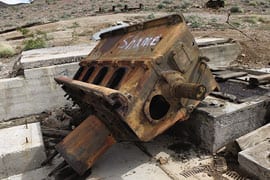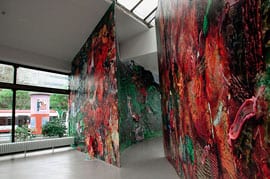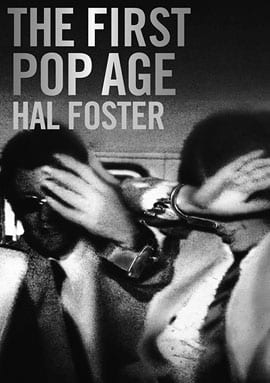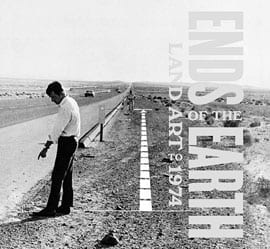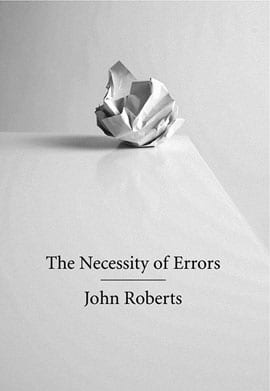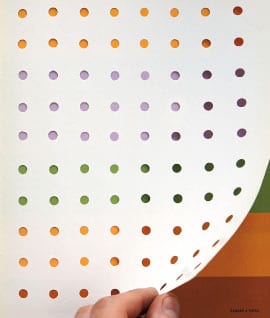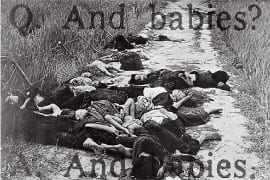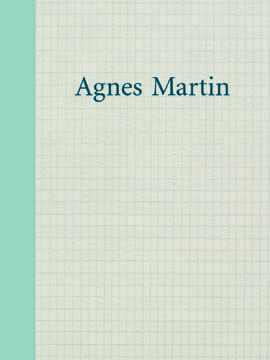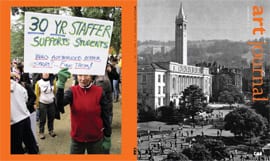By Josephine Halvorson
The nineteenth-century painter Samuel Palmer lived within two hundred yards of the cemetery, making drawings, notes, and paintings in what he called the Valley of Visions in an effort to “bring up a mystic glimmer.” Sinclair, London Orbital Acid rain has eroded the words. Lichens, like Van Gogh blooms in orange and yellow, cling to the mauve stone.
Ground Control: Painting in the Work of Cosima von Bonin
By Gregory H. Williams
During the past decade a steady flow of critical writing on contemporary painting has appeared, much of it seeking to define changes to the practice that have taken place since 1990. In several often-cited essays, a shared theme has emerged in which late-twentieth-century painting is described as undergoing a crisis of containment.
Pigment vs. Pixel: Painting in an Era of Light-Based Images
By Luke Smythe
Copied from a small and fuzzy photograph clipped from a newspaper in 2003, Gerhard Richter’s Silikat paintings depict a honeycomb array of silicate particles, modeled on the structure of a butterfly wing.
We Are Pop People
By Joshua Shannon
Anyone seeking a crisp argument for the importance of contemporary art history should welcome the introduction of Hal Foster’s latest book, The First Pop Age. Foster justifies his careful look back at five key Pop artists by persuasively arguing that their work reveals and investigates a new stage, ascendant in the early 1960s, in the history of capitalist culture.
This Land Is Their Land
By Suzaan Boettger
Ends of the Earth: Land Art to 1974, the bold title of the exhibition and catalogue organized by the Museum of Contemporary Art, Los Angeles, and on view there in 2012 and later at Munich’s Haus der Kunst, evokes the grand ambitions of artists’ environmental imaginations in the early 1970s.
Lights, Camera, Action!
By Mechtild Widrich
Should we judge a book by its cover? The image on the front of the massive new publication on a taboo-breaking group of Austrian postwar artists shows a crowd of people gazing, some with obvious disapproval, into the camera. Among them we see policemen —something has happened or is about to, a crime perhaps—but we cannot see what has given rise to the incident.
Reign of Error
By Barry Schwabsky
John Roberts is one of the more original and independent thinkers among contemporary art historians, and his wide-ranging reflections often take him well outside the boundaries of the discipline. In fact, he sometimes seems at pains to obscure what might be called the art-historical use-value of his work in order to underline its broader implications; he prefers to be seen, it appears, as a sort of unlicensed philosopher.
Administered Occupation: Art and Politics at the 7th Berlin Biennale
By Olga Kopenkina
In one of his best-known videos, the artist Artur Zmijewski is seen trying to persuade a former Nazi concentration camp prisoner to “renew” the number tattooed on the man’s forearm. In another film, Berek, naked adults play a game of tag in the gas chamber. But it is not the controversy about Zmijewski’s works that prompted his appointment as curator of the 7th Berlin Biennale, which took place at the KW Institute of Contemporary Art (Kunst Werke) and various locations in Berlin April 27–July 1, 2012.
Attention Deficit
By Katy Siegel
Perhaps minor among reasons to celebrate the fact that the world did not end as predicted on 12.12.12 is that Art Journal is a little behind in its publication schedule.
Planet of the Apes: John Szarkowski, My Lai, and The Animals
By Chris Balaschak
In 1969 Winogrand published The Animals alongside an exhibition of the same name at the Museum of Modern Art, New York (MoMA). Though it has never been seen as such, it was a timely project, and represents a satire of American society during the height of a war “unassimilable” by popular culture.
Agnes Martin, Under New Auspices
By Karen L. Schiff
Finally—a book of criticism about Agnes Martin. No other book of writing about this singular, revered artist has been in print for many years. And though Martin (1912–2004) has been an esteemed presence in the art world since at least the early 1960s, there exists no monograph, no biography, no previous collection of criticism.
What Are You Working On?
By Katy Siegel
This issue of Art Journal comes after two issues that tightly revolved around a single concept: the medium of print (Winter 2011) and the Pacific Standard Time initiative (Spring 2012).

